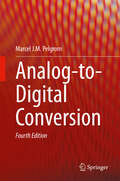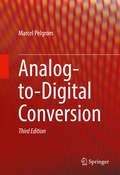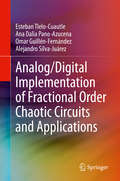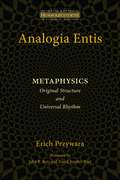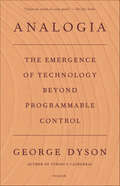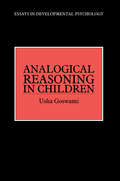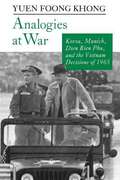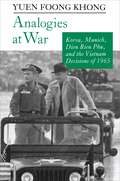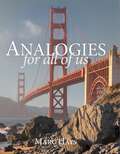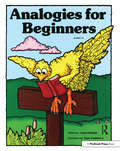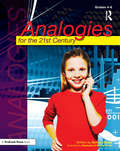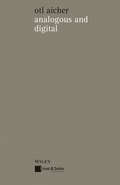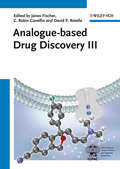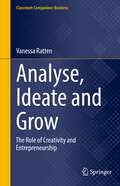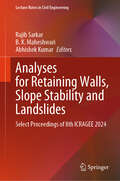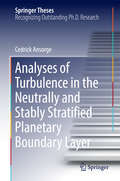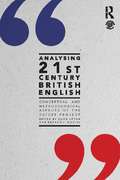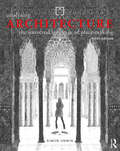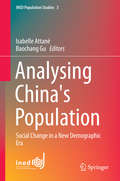- Table View
- List View
Analog-to-Digital Conversion
by Marcel J.M. PelgromThis textbook is appropriate for use in graduate-level curricula in analog-to-digital conversion, as well as for practicing engineers in need of a state-of-the-art reference on data converters. It discusses various analog-to-digital conversion principles, including sampling, quantization, reference generation, Nyquist architectures and sigma-delta modulation. This book presents an overview of the state-of-the-art in this field and focuses on issues of optimizing accuracy and speed, while reducing the power level. This new, fourth edition emphasizes novel calibration concepts, the specific requirements of systems, the consequences of advanced technology and the need for a more statistical approach to accuracy. Pedagogical enhancements to this edition include additional, new exercises, solved examples to introduce all key, new concepts and warnings, remarks and hints, from a practitioner's perspective, wherever appropriate. Considerable background information and practical tips, from designing a PCB, to lay-out aspects, to trade-offs on system level, complement the discussion of basic principles, making this book a valuable reference for the experienced engineer.
Analog-to-Digital Conversion
by Marcel PelgromA book is like a window that allows you to look into the world. The window is shaped by the author and that makes that every window presents a unique view of the world. This is certainly true for this book. It is shaped by the topics and the projects throughout my career. Even more so, this book re'ects my own style of working and thinking. That starts already in Chap. 2. When I joined Philips Research in 1979, many of my colleagues used little paper notebooks to keep track of the most used equations and other practical things. This notebook was the beginning for Chap. 2: a collection of topics that form the basis for much of the other chapters. Chapter2 is not intended to explain these topics, but to refresh your knowledge and help you when you need some basics to solve more complex issues. In the chapters discussing the fundamental processes of conversion, you will r- ognize my preoccupation with mathematics. I really enjoy ?nding an equation that properly describes the underlying mechanism. Nevertheless mathematics is not a goalonitsown:theequationshelptounderstandthewaythevariablesareconnected to the result. Real insight comes from understanding the physics and electronics. In the chapters on circuit design I have tried to reduce the circuit diagrams to the s- plest form, but not simpler. . . I do have private opinions on what works and what should not be applied.
Analog/Digital Implementation of Fractional Order Chaotic Circuits and Applications
by Esteban Tlelo-Cuautle Ana Dalia Pano-Azucena Omar Guillén-Fernández Alejandro Silva-JuárezThis book details the simulation and optimization of integer and fractional-order chaotic systems, and how they can be implemented in the analog and digital domains using FPAAs and FPGAs. Design guidelines are provided to use commercially available electronic devices, and to perform hardware descriptions of integer/fractional-order chaotic systems programming in VHDL. Finally, several engineering applications oriented to cryptography, internet of things, robotics and chaotic communications, are detailed to highlight the usefulness of FPAA/FPGA based integer/fractional-order chaotic systems.Provides guidelines to implement fractional-order derivatives using commercially available devices;Describes details on using FPAAs to approach fractional-order chaotic systems;Includes details on using FPGAs to approach fractional-order chaotic systems, programming in VHDL and reducing hardware resources;Discusses applications to cryptography, internet of things, robotics and chaotic communications.
Analogia Entis: Original Structure and Universal Rhythm (Ressourcement: Retrieval and Renewal in Catholic Thought (RRRCT))
by Erich PrzywaraAlthough Erich Przywara (1889–1972) was one of the preeminent Catholic theologians of his time and a profound influence on such people as Hans Urs von Balthasar and Joseph Ratzinger, he has remained virtually unknown in North America. This volume includes Przywara’s groundbreaking Analogia Entis, originally published in 1932, and his subsequent essays on the concept analogia entis -- the analogy between God and creation -- which has currency in philosophical and theological circles today.
Analogia: The Emergence of Technology Beyond Programmable Control
by George DysonNamed one of WIRED’s "The Best Pop Culture That Got Us Through 2020"In Analogia, technology historian George Dyson presents a startling look back at the analog age and life before the digital revolution—and an unsettling vision of what comes next.In 1716, the philosopher and mathematician Gottfried Wilhelm Leibniz spent eight days taking the cure with Peter the Great at Bad Pyrmont in Saxony, trying to persuade the tsar to launch a voyage of discovery from Russia to America and to adopt digital computing as the foundation for a remaking of life on earth. In two classic books, Darwin Among the Machines and Turing’s Cathedral, George Dyson chronicled the realization of the second of Leibniz’s visions. In Analogia, his pathbreaking new book, he brings the story full circle, starting with the Russian American expedition of 1741 and ending with the beyond-digital revolution that will completethe transformation of the world.Dyson enlists a startling cast of characters, from the time of Catherine the Great to the age of machine intelligence, and draws heavily on his own experiences at the Institute for Advanced Study in Princeton, New Jersey, and onward to the rain forest of the Northwest Coast. We are, Dyson reveals, entering a new epoch in human history, one driven by a generation of machines whose powers are no longer under programmable control. Includes black-and-white illustrations
Analogical Investigations
by Lloyd, G. E. R.Western philosophy and science are responsible for constructing some powerful tools of investigation, aiming at discovering the truth, delivering robust explanations, verifying conjectures, showing that inferences are sound and demonstrating results conclusively. By contrast reasoning that depends on analogies has often been viewed with suspicion. Professor Lloyd first explores the origins of those Western ideals, criticises some of their excesses and redresses the balance in favour of looser, admittedly non-demonstrative analogical reasoning. For this he takes examples both from ancient Greek and Chinese thought and from the materials of recent ethnography to show how different ancient and modern cultures have developed different styles of reasoning. He also develops two original but controversial ideas, that of semantic stretch (to cast doubt on the literal/metaphorical dichotomy) and the multidimensionality of reality (to bypass the realism versus relativism and nature versus nurture controversies).
Analogical Reasoning in Children (Essays in Developmental Psychology)
by Usha GoswamiAnalogical reasoning is a fundamental cognitive skill, involved in classification, learning, problem-solving and creative thinking, and should be a basic building block of cognitive development. However, for a long time researchers have believed that children are incapable of reasoning by analogy. This book argues that this is far from the case, and that analogical reasoning may be available very early in development. Recent research has shown that even 3-year-olds can solve analogies, and that infants can reason about relational similarity, which is the hallmark of analogy.The book traces the roots of the popular misconceptions about children's analogical abilities and argues that when children fail to use analogies, it is because they do not understand the relations underlying the analogy rather than because they are incapable of analogical reasoning. The author argues that young children spontaneously use analogies in learning, and that their analogies can sometimes lead them into misconceptions. In the "real worlds" of their classrooms, children use analogies when learning basic skills like reading, and even babies seem to use analogies to learn about the world around them.
Analogies at War: Korea, Munich, Dien Bien Phu, and the Vietnam Decisions of 1965
by Yuen Foong KhongFrom World War I to Operation Desert Storm, American policymakers have repeatedly invoked the "lessons of history" as they contemplated taking their nation to war. Do these historical analogies actually shape policy, or are they primarily tools of political justification? Yuen Foong Khong argues that leaders use analogies not merely to justify policies but also to perform specific cognitive and information-processing tasks essential to political decision-making. Khong identifies what these tasks are and shows how they can be used to explain the U. S. decision to intervene in Vietnam. Relying on interviews with senior officials and on recently declassified documents, the author demonstrates with a precision not attained by previous studies that the three most important analogies of the Vietnam era--Korea, Munich, and Dien Bien Phu--can account for America's Vietnam choices. A special contribution is the author's use of cognitive social psychology to support his argument about how humans analogize and to explain why policymakers often use analogies poorly.
Analogies at War: Korea, Munich, Dien Bien Phu, and the Vietnam Decisions of 1965
by Yuen Foong KhongFrom World War I to Operation Desert Storm, American policymakers have repeatedly invoked the "lessons of history" as they contemplated taking their nation to war. Do these historical analogies actually shape policy, or are they primarily tools of political justification? Yuen Foong Khong argues that leaders use analogies not merely to justify policies but also to perform specific cognitive and information-processing tasks essential to political decision-making. Khong identifies what these tasks are and shows how they can be used to explain the U.S. decision to intervene in Vietnam. Relying on interviews with senior officials and on recently declassified documents, the author demonstrates with a precision not attained by previous studies that the three most important analogies of the Vietnam era--Korea, Munich, and Dien Bien Phu--can account for America's Vietnam choices. A special contribution is the author's use of cognitive social psychology to support his argument about how humans analogize and to explain why policymakers often use analogies poorly.
Analogies for All of Us: A revelation in relating to your world using analogies and figures of speech
by Mac HaysDiscovering and naming relationships is central to human thinking and communication. Studying analogies gives students tools to become better thinkers and better communicators. This book includes a full semester of basic analogies instruction and practice, as well as opportunities for students to create figures of speech associated with each analogy lesson. This book is an unprecedented integration of thinking skills, writing practice, reading comprehension, poetry appreciation, and story-telling. It is self-teaching, meaning no other resources are needed; it is intended for children and parents to use together. Structured according to the rhythms of the Challenge A seminar, one day of each week contains instruction in analogies followed by four days practicing what was learned together in the Challenge A seminar.
Analogies for Beginners: Grades 1-3
by Lynne ChathamAn analogy is a comparison that points out the similarities between things that are different in all other respects. Teaching students how to solve analogies not only develops their logical thinking, but also builds visual awareness and verbal proficiency.The seven different types of visual analogies and 14 different verbal analogies in Analogies for Beginners are perfect for beginning lessons in logical reasoning, flexible thinking, and vocabulary. Each page gives students an example of the type of analogy that is being introduced and then provides 7 (visual) or 10 (verbal) problems for them to solve. This combination of verbal and visual formats is an ideal way to introduce logical thinking in primary grades. Whether you have time for one analogy a day or a worksheet a week, students will benefit in many ways when analogies are part of your curriculum. The use of visual analogies is beneficial for developing visual analysis even for older students, but especially useful for nonreaders and students with developing English skills. The verbal analogies provide students with exercises that require them to use word comprehension and also to examine various characteristics, uses, and relationships.This is one of a series of analogy books. For younger students, use First Time Analogies. For older students, use Thinking Through Analogies, Analogies for the 21st Century, or Advancing Though Analogies. Grades 1-3
Analogies for the 21st Century: Grades 4-6
by Bonnie L. RisbyThis is it! Here's the perfect venue for intermediate teachers to combine thinking skills and vocabulary development. Step into the 21st century with lessons that not only present students with analogies, but also provide them with instructions on how to best solve these verbal puzzles.An analogy is a comparison between two things. It points out the similarities or likenesses between things that might be different in all other respects. These exercises not only build thinking skills and make students more flexible and analytical; they also enhance vocabulary and writing skills.Intermediate students will get a jump on thinking skills and test taking strategies with these sure-to-please exercises. Whether this book is their first encounter with analogies or whether they are veterans with a great deal of experience, Analogies for the 21st Century gives them the tools they need in a fun-to-use format. It provides thinking strategies to help recognize the unique relationships between paired items and how these relationships can be replicated. Each lesson introduces new types of analogies, gives examples, and offers hints on solving the analogies. Vocabulary reflects today's culture, and helpful hints help students to build skills that will allow them to perform better on tests.This is one of a series of analogy books. For younger students, use First Time Analogies or Analogies for Beginners. For older students, use Thinking Through Analogies or Advancing Though Analogies. Grades 4-6
Analogies in International Investment Law and Arbitration
by Valentina VadiAlthough investment treaty arbitration has become the most common method for settling investor-state disputes, some scholars and practitioners have expressed concern regarding the magnitude of decision-making power allocated to investment treaty tribunals. Many of the recent arbitral awards have determined the boundary between two conflicting values: the legitimate sphere for state regulation in the pursuit of public goods, and the protection of foreign private property from state interference. Can comparative reasoning help adjudicators in interpreting and applying broad and open-ended investment treaty provisions? Can the use of analogies contribute to the current debate over the legitimacy of investor-state arbitration, facilitating the consideration of the commonweal in the same? How should comparisons be made? What are the limits of comparative approaches to investment treaty law and arbitration? This book scrutinises the impact a comparative approach can have on investment law, and identifies a method for drawing sound analogies.
Analogous and Digital
by Otl AicherOtl Aicher (1922-1991) was an outstanding personality in modern design, he was a co-founder of the legendary Hochschule fur Gestaltung (HfG), the Ulm School of Design, Germany. His works since the fifties of the last century in the field of corporate design and his pictograms for the 1972 Summer Olympics in Munich are major achievements in the visual communication of our times. "An integral component of Aicher's work is that it is anchored in a "philosophy of making" inspired by such thinkers as Ockham, Kant or Wittgenstein, a philosophy concerned with the prerequisites and aims, the objects and claims, of design. Aicher's complete theoretical and practical writings on design (which include all other aspects of visual creativity, such as architecture) are available with this new edition of the classic work. If Aicher prefers the analogous and concrete to the digital and abstract he does it with a philosophical intention. He relativizes the role of pure reason. He criticizes the rationality of Modernism as a result of the dominance of purely abstract thinking. Anyone who prefers the abstract to the concrete does not only misunderstand the mutual dependence of concept and view. In Aicher's judgement he is also creating a false hierarchy, a rank order that is culturally fatal. Things that are digital and abstract are not greater, higher and more important than things that are analogous and concrete." Wilhelm Vossenkuhl
Analogue Gravity Phenomenology: Analogue Spacetimes and Horizons, from Theory to Experiment (Lecture Notes in Physics #870)
by Ugo Moschella Vittorio Gorini Sergio Cacciatori Francesco Belgiorno Stefano Liberati Daniele FaccioAnalogue Gravity Phenomenology is a collection of contributions that cover a vast range of areas in physics, ranging from surface wave propagation in fluids to nonlinear optics. The underlying common aspect of all these topics, and hence the main focus and perspective from which they are explained here, is the attempt to develop analogue models for gravitational systems. The original and main motivation of the field is the verification and study of Hawking radiation from a horizon: the enabling feature is the possibility to generate horizons in the laboratory with a wide range of physical systems that involve a flow of one kind or another. The years around 2010 and onwards witnessed a sudden surge of experimental activity in this expanding field of research. However, building an expertise in analogue gravity requires the researcher to be equipped with a rather broad range of knowledge and interests. The aim of this book is to bring the reader up to date with the latest developments and provide the basic background required in order to appreciate the goals, difficulties, and success stories in the field of analogue gravity. Each chapter of the book treats a different topic explained in detail by the major experts for each specific discipline. The first chapters give an overview of black hole spacetimes and Hawking radiation before moving on to describe the large variety of analogue spacetimes that have been proposed and are currently under investigation. This introductory part is then followed by an in-depth description of what are currently the three most promising analogue spacetime settings, namely surface waves in flowing fluids, acoustic oscillations in Bose-Einstein condensates and electromagnetic waves in nonlinear optics. Both theory and experimental endeavours are explained in detail. The final chapters refer to other aspects of analogue gravity beyond the study of Hawking radiation, such as Lorentz invariance violations and Brownian motion in curved spacetimes, before concluding with a return to the origins of the field and a description of the available observational evidence for horizons in astrophysical black holes.
Analogue Quantum Simulation: A New Instrument for Scientific Understanding
by Dominik Hangleiter Jacques Carolan Karim P. ThébaultThis book presents fresh insights into analogue quantum simulation. It argues that these simulations are a new instrument of science. They require a bespoke philosophical analysis, sensitive to both the similarities to and the differences with conventional scientific practices such as analogical argument, experimentation, and classical simulation.The analysis situates the various forms of analogue quantum simulation on the methodological map of modern science. In doing so, it clarifies the functions that analogue quantum simulation serves in scientific practice. To this end, the authors introduce a number of important terminological distinctions. They establish that analogue quantum ‘computation' and ‘emulation' are distinct scientific practices and lead to distinct forms of scientific understanding. The authors also demonstrate the normative value of the computation vs. emulation distinction at both an epistemic and a pragmatic level.The volume features a range of detailed case studies focusing on: i) cold atom computation of many-body localisation and the Higgs mode; ii) photonic emulation of quantum effects in biological systems; and iii) emulation of Hawing radiation in dispersive optical media. Overall, readers will discover a normative framework to isolate and support the goals of scientists undertaking analogue quantum simulation and emulation. This framework will prove useful to both working scientists and philosophers of science interested in cutting-edge scientific practice.
Analogue-based Drug Discovery III
by Janos Fischer C. Robin Ganellin David P. RotellaMost drugs are analogue drugs. There are no general rules how a new drug can be discovered, nevertheless, there are some observations which help to find a new drug, and also an individual story of a drug discovery can initiate and help new discoveries. Volume III is a continuation of the successful book series with new examples of established and recently introduced drugs. The major part of the book is written by key inventors either as a case study or a study of an analogue class. With its wide range across a variety of therapeutic fields and chemical classes, this is of interest to virtually every researcher in drug discovery and pharmaceutical chemistry, and -- together with the previous volumes -- constitutes the first systematic approach to drug analogue development.
Analyse, Ideate and Grow: The Role of Creativity and Entrepreneurship (Classroom Companion: Business)
by Vanessa RattenThis book explores that in order to survive in the current dynamic and changing business environment, individuals need to analyse and ideate. This book provides analysis on this process involving investigating how and why changes take place and what they mean for society. This book takes into account altering environmental conditions that influence business strategy. Further, to do a proper analysis takes time and skill thus it is important to know what resources and expertise is required. This book shows that the ideation process involves more creativity in terms of thinking outside the box. This involves new thought processes about emerging technological change that will influence business directions. This book states that ideation is a process that requires some degree of flexibility as market circumstances mean constant innovation is required.
Analyses for Retaining walls, Slope Stability and Landslides: Select Proceedings of 8th ICRAGEE 2024 (Lecture Notes in Civil Engineering #568)
by Abhishek Kumar Rajib Sarkar B. K. MaheshwariThis book will present the select proceedings of the 8th International Conference on Recent Advances in Geotechnical Earthquake Engineering and Soil Dynamics (8ICRAGEE) held at the Indian Institute of Technology (IIT), Guwahati between December 11 and 14, 2024. It contains the latest research papers covering the contributions and accomplishments in geotechnical earthquake engineering and soil dynamics in the last four years. The five volumes of the book cover a wide range of topics, including but not limited to seismic hazard analysis, wave propagation and site characterization, dynamic properties and liquefaction of soils, pile foundations, offshore foundations, seismic design of retaining structures and dams, seismic slope stability and landslides, dynamic soil-structure interaction, seismic design of structures. Further, recent developments on these topics are covered in different chapters. This book will be valuable not only for researchers and professionals but also for drawing an agenda for future courses of action from the perspective of geotechnical earthquake engineering, keeping the national need at the forefront.
Analyses of Turbulence in the Neutrally and Stably Stratified Planetary Boundary Layer (Springer Theses)
by Cedrick AnsorgeThis thesis presents a study of strong stratification and turbulence collapse in the planetary boundary layer, opening a new avenue in this field. It is the first work to study all regimes of stratified turbulence in a unified simulation framework without a break in the paradigms for representation of turbulence. To date, advances in our understanding and the parameterization of turbulence in the stable boundary layer have been hampered by difficulties simulating the strongly stratified regime, and the analysis has primarily been based on field measurements. The content presented here changes that paradigm by demonstrating the ability of direct numerical simulation to address this problem, and by doing so to remove the uncertainty of turbulence models from the analysis. Employing a stably stratified Ekman layer as a simplified physical model of the stable boundary layer, the three stratification regimes observed in nature-- weakly, intermediately and strongly stratified--are reproduced, and the data is subsequently used to answer key, long-standing questions. The main part of the book is organized in three sections, namely a comprehensive introduction, numerics, and physics. The thesis ends with a clear and concise conclusion that distills specific implications for the study of the stable boundary layer. This structure emphasizes the physical results, but at the same time gives relevance to the technical aspects of numerical schemes and post-processing tools. The selection of the relevant literature during the introduction, and its use along the work appropriately combines literature from two research communities: fluid dynamics, and boundary-layer meteorology.
Analysing 21st Century British English: Conceptual and Methodological Aspects of the 'Voices' Project
by Bethan L. Davies Clive UptonThe Voices project of the British Broadcasting Corporation, a recent high-profile media investigation, gathered contemporary English dialect samples from all over the UK and invited contributions from the public to a dedicated website. This book explores both issues of ideology and representation behind the media project and uses to which the emerging data can be put in the study of language variation and change. Two lead-in chapters, written from the complementary perspectives of a broadcast media specialist, Simon Elmes, and an academic linguist, David Crystal, set the project in the BBC’s historical, social, and linguistic contexts. Following these, authorities in a range of specialisms concerned with uses and representations of language varieties address various aspects of the project’s potential, in three broad sections: Linguistic explorations of the representations of language and the debates on language evoked by the data. The linguistic product of the project, including lexical, phonological, and grammatical investigations. Technical aspects of creating maps from the large electronic Voices database. An interactive companion website provides the means to access, explore, and make use of raw linguistic data, along with interpretive maps created from it, all accompanied by full explanations. Analysing 21st Century British English brings together key research and is essential reading for advanced undergraduate students, postgraduate students and researchers working in the areas of language variation, dialect and sociolinguistics. Contributors: David Crystal, Bethan Davies, Susie Dent, Simon Elmes, Holly Gilbert, Jon Herring, John Holliday, Alexandra Jaffe, Tommaso Milani, Rob Penhallurick, Jonnie Robinson, Mooniq Shaikjee, Ann Thompson, Will Turner, Clive Upton, Martijn Wieling.
Analysing Architecture
by Simon UnwinNow in its fourth edition, Analysing Architecture has become internationally established as the best introduction to architecture. Aimed primarily at those wishing to become professional architects, it also offers those in disciplines related to architecture (from archaeology to stage design, garden design to installation art), a clear and accessible insight into the workings of this rich and fascinating subject. With copious illustrations from his own notebooks, the author dissects examples from around the world and all periods of history to explain underlying strategies in architectural design and show how drawing may be used as a medium for analysis. This new edition of Analysing Architecture is revised and expanded. Notably, the chapter on ‘Basic Elements of Architecture’ has been enlarged to discuss the ‘powers’ various architectural elements offer the architect. Three new chapters have been added to the section on ‘Themes in Spatial Organisation’, covering ‘Occupying the In-between’, ‘Inhabited Wall’ and ‘Refuge and Prospect’. Two new examples – a Mud House from Kerala, India and the Mongyo-tei (a tea house) from Kyoto, Japan – have been added to the ‘Case Studies’ at the end of the book. The ‘Select Bibliography’ has been expanded and the ‘Index’ revised. Works of architecture are instruments for managing, orchestrating, modifying our relationship with the world around us. They frame just about everything we do. Architecture is complex, subtle, frustrating… but ultimately extremely rewarding. It can be a difficult discipline to get to grips with; nothing in school quite prepares anyone for the particular demands of an architecture course. But this book will help. Analysing Architecture is the foundation volume of a series of books by Simon Unwin exploring the workings of architecture. Other books in the series include Twenty Buildings Every Architect Should Understand and Exercises in Architecture.
Analysing Architecture: the universal language of place-making
by Simon UnwinNow in its fifth edition, Analysing Architecture has become internationally established as the best introduction to architecture. Aimed primarily at those studying architecture, it offers a clear and accessible insight into the workings of this rich and fascinating subject. With copious illustrations from his own notebooks, the author dissects examples from around the world and all periods of history to explain the underlying strategies in architectural design and show how drawing may be used as a medium for analysis. In this new edition, Analysing Architecture has been revised and expanded. Notably, the chapter on ‘How Analysis Can Help Design’ has been redeveloped to clearly explain this crucially important aspect of study to a beginner readership. Four new chapters have been added to the section dealing with Themes in Spatial Organisation, on ‘Axis’, ‘Grid’, ‘Datum Place’ and ‘Hidden’. Material from the 'Case Studies' in previous editions has been redistributed amongst earlier chapters. The ‘Introduction' has been completely rewritten; and the format of the whole book has been adjusted to allow for the inclusion of more and better illustrative examples. Works of architecture are instruments for managing, orchestrating, modifying our relationship with the world around us. They frame just about everything we do. Architecture is complex, subtle, frustrating… but ultimately extremely rewarding. It can be a difficult discipline to get to grips with; nothing in school quite prepares anyone for the particular demands of an architecture course. But this book will help.
Analysing China's Population: Social Change in a New Demographic Era (INED Population Studies #3)
by Isabelle Attané Baochang GuBased on China's recently released 2010 population census data, this edited volume analyses the most recent demographic trends in China, in the context of significant social and economic upheavals. The editor and the expert contributors describe the main features of China's demography, and focus on the details of this latest phase of its demographic transition. The book explores such striking characteristics of China's demography as the changing age and sex population structure; recent trends in marriage and divorce; fertility trends with a focus on sex imbalance at birth; the demography of the ethnic minorities and recent mortality trends by sex. Analysing China's Population: Social Change in a New Demographic Era examines and assesses the impact of changes that in the coming decades will be crucial for individuals, and the larger society and economy of the nation.
Analysing Data: A Time-Saving Guide
by Helen KaraWhen you've collected all your data, what do you do next? Whether it's qualitative or quantitative, this e-book explains how to prepare, code, and analyse your data. The book offers clear guidance to help you turn a morass of raw data into cogent findings.
